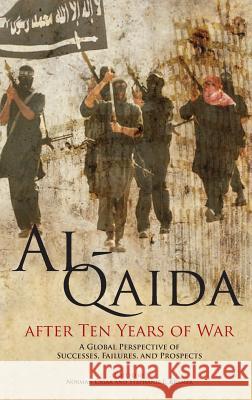Al-Qaida After Ten Years of War: A Global Perspective of Successes, Failures, and Prospects » książka
Al-Qaida After Ten Years of War: A Global Perspective of Successes, Failures, and Prospects
ISBN-13: 9781780397832 / Angielski / Twarda / 2012 / 216 str.
Al-Qaida After Ten Years of War: A Global Perspective of Successes, Failures, and Prospects
ISBN-13: 9781780397832 / Angielski / Twarda / 2012 / 216 str.
(netto: 274,37 VAT: 5%)
Najniższa cena z 30 dni: 271,35 zł
ok. 13-18 dni roboczych.
Darmowa dostawa!
Since the September 2001 attacks on the World Trade Center and the Pentagon, the United States has been at war with Al-Qaida. Over the past 10 years, counterterrorism efforts have disrupted its main training facilities and eliminated much of the core leadership structure, including the mastermind Usama Bin Ladin. Despite this, Al-Qaida has proved resilient. While the core leadership has been compromised, regional Al-Qaida offshoots and affiliated Islamist terrorist groups have formed, developed, and become prominent in their own right. To aid in examining and explaining Al-Qaida's trajectory, the Minerva Initiative at Marine Corps University hosted a conference in the spring of 2011, just days before Bin Ladin's demise. The panels at this conference addressed diverse issues such as Al-Qaida's overarching strategy; the degree of control that central Al-Qaida leadership maintains over regional franchises; and the strategies, tactics, successes, and failures in each theater of operation. The resulting papers in Al-Qaida after Ten Years of War contribute to the ongoing and ever-evolving net assessment of Al-Qaida and its future prospects, and they help inform the crafting of a war termination phase with Al-Qaida.
Since the September 2001 attacks on the World Trade Center and the Pentagon, the United States has been at war with Al-Qaida. Over the past 10 years, counterterrorism efforts have disrupted its main training facilities and eliminated much of the core leadership structure, including the mastermind Usama Bin Ladin. Despite this, Al-Qaida has proved resilient. While the core leadership has been compromised, regional Al-Qaida offshoots and affiliated Islamist terrorist groups have formed, developed, and become prominent in their own right. To aid in examining and explaining Al-Qaidas trajectory, the Minerva Initiative at Marine Corps University hosted a conference in the spring of 2011, just days before Bin Ladins demise. The panels at this conference addressed diverse issues such as Al-Qaidas overarching strategy; the degree of control that central Al-Qaida leadership maintains over regional franchises; and the strategies, tactics, successes, and failures in each theater of operation. The resulting papers in Al-Qaida after Ten Years of War contribute to the ongoing and ever-evolving net assessment of Al-Qaida and its future prospects, and they help inform the crafting of a war termination phase with Al-Qaida.











